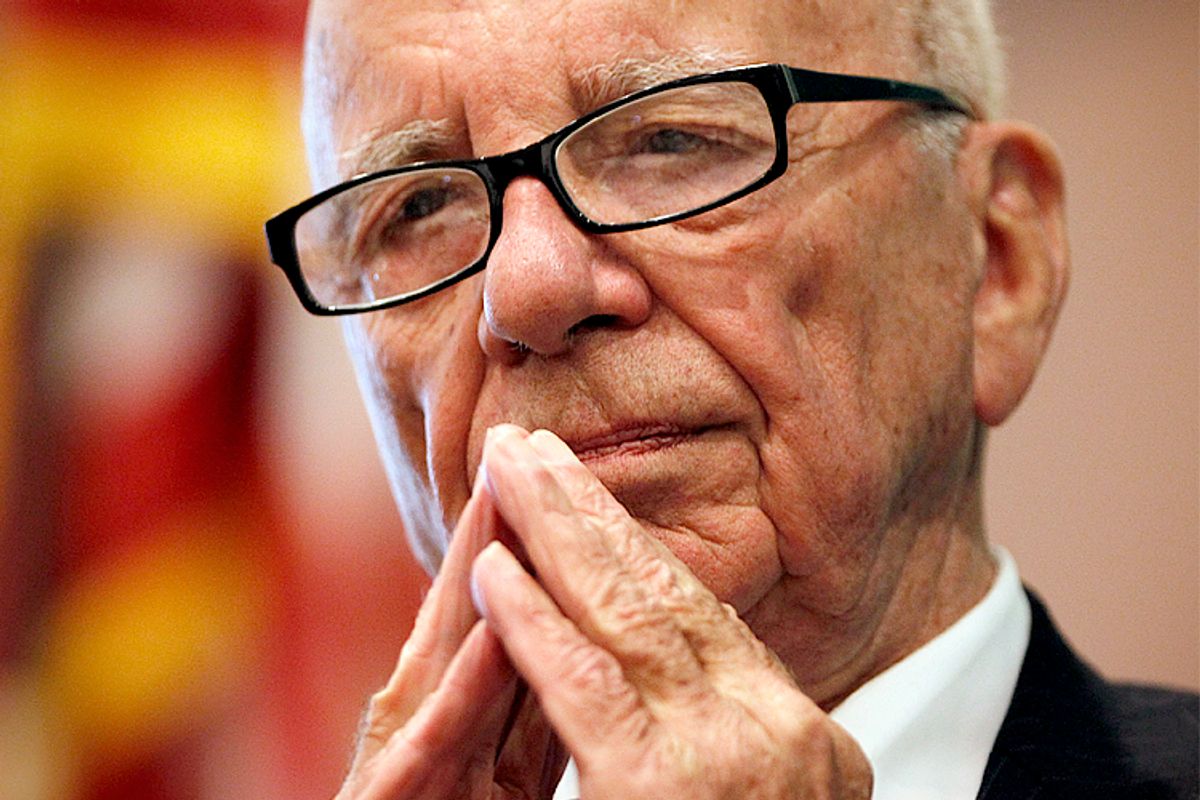Phew! What a scorcher of a pair! In a SHOCKHORROR duo of tweets Wednesday, desiccated tabloid monger Rupert Murdoch indicated that it may be time to put something other than bare breasts on the Sun's infamous Page 3.
For 44 years, the Sun has served up shapely topless girls as the first thing readers view when they open the newspaper – and I am using the word "newspaper" very loosely here. The Sun has long been legendary, and controversial, for displaying breasts along with headlines, or as Billy Bragg long ago sang, being the place "where politics mix with bingo and tits." Until 2003, girls as young as 16 – including '80s pop star Samantha Fox -- graced the page wearing only flirtatious smiles and bikini bottoms. More recently, the Page 3 girl has continued to thrive well into the digital age, branching out with a stand-alone online destination and launching, of course, a self-congratulatory and oversexed breast cancer awareness campaign. But she has also incited a growing and vocal push to retire once and for all, most notably via the No More Page 3 campaign, which explains simply that "Boobs aren't news." And now, Murdoch himself seems ready to let it go.
Before returning to his job of ragging on Piers Morgan Wednesday, Murdoch mused, "Brit feminists bang on forever about page 3. I bet never buy paper. I think old fashioned but readers seem to disagree," and added, "Page 3 again. Aren't beautiful young women more attractive in at least some fashionable clothes? Your opinions please." It felt like a very public attempt at testing waters, and seeing if there's enough support out there to justify a phase-out of the venerable forum for fresh daily nipples.
The response has been intriguing. If he's paying attention, Murdoch might want to note that the hashtag #nomorepage3 soon began trending on Twitter, perhaps best summed up by the person who observed, "Page 3 really belongs to the Benny Hill era. It's had its day and topless models in a daily newspaper simply aren't necessary." Of course, when you even hint about taking away the boobies, there will always be those who strongly, petulantly object. Reading through the Twitter responses, you'll find a fair amount of male rage at "those feminist demons" and asking, "Who let the hypocrite feminists loose on the Internet?"
Murdoch's assessment that the Page 3 girl now seems "old-fashioned" is certainly an accurate one, but he's not the kind of guy to let go of a thing if it's working. His apparent changing heart may have more to do with the changing realities of demographics, and the desire to hang on to his readership. His mention that feminists likely don't buy his paper is probably not a statement of regret over offending anybody but a declaration of intention toward a potential audience. Furthermore, serving up young women, breasts a-go-go, isn't exactly in line with the paper's recent and very family-friendly "Kids Get Reading" literacy campaign. If Murdoch and company want families sitting down and reading his newspaper together, he's got a tougher sell with what he's currently got going on front and center. And with the No More Page 3 campaign garnering more than 200,000 signatures and the support of the Scottish Parliament, the Royal College of Midwives, the British Youth Council and several other major organizations, as well as 33 universities that have vowed to stop selling the Sun until it revamps its format, it may simply be a matter of crunching the numbers to see that it's more economically viable to end the page than continue it.
Supporters of Page 3, like the Guardian commenter who explained, "The word for a heterosexual male appreciating the female form is 'normal,'" or the indignant reader who stated, "Nobody forces these women to look at the photos. They can skip the page or buy a different newspaper. But somehow they feel they have the right to deny others their choice. Who are they to choose for everyone else?" miss the point about why it should go. There's nothing inherently wrong with pretty, topless girls. There is, however, something wrong -- and hopelessly outdated -- with a venue that's ostensibly for news and information blatantly giving readers women's unclothed bodies as part of the daily fare. It send the message that this paper is basically just for those "normal" straight men, and that the most prominent, most important place it will give a woman there is one in which she's a sex object to be leered at.
Whatever its next step, the Guardian notes that the paper "hasn't given up publishing pictures of scantily clad women, of course." And when you note that the most popular story on HuffPo on any given day almost inevitably involves the phrase "wardrobe malfunction" and that Murdoch's imperative for "beautiful young women" still seems a go, it's safe to assume the Sun will no doubt continue to find new ways to appeal to our bottomless public appetite for breasts. But there's at least the possibility now of evolution, of less institutionalized objectification. And phwoar, what a gorgeous concept.



Shares